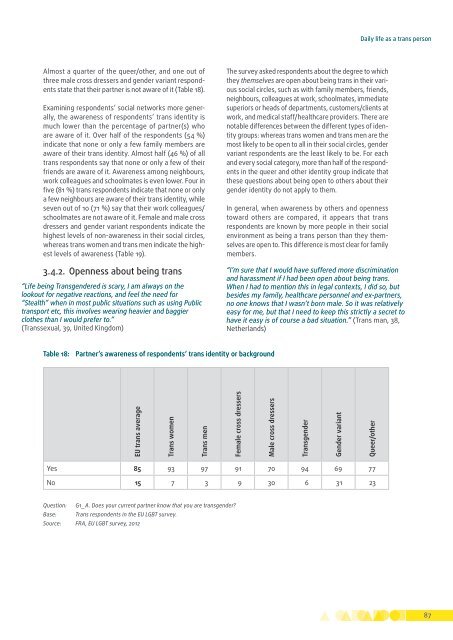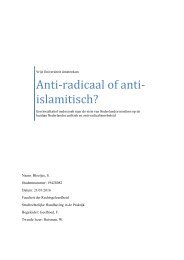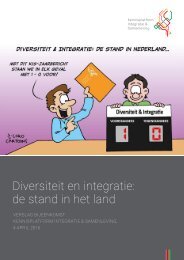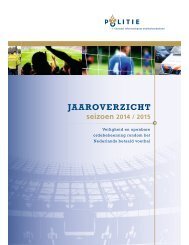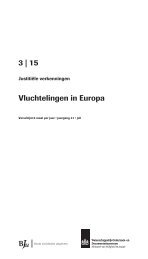fra-2014-being-trans-eu-comparative_en
fra-2014-being-trans-eu-comparative_en
fra-2014-being-trans-eu-comparative_en
Create successful ePaper yourself
Turn your PDF publications into a flip-book with our unique Google optimized e-Paper software.
Daily life as a <strong>trans</strong> personAlmost a quarter of the queer/other, and one out ofthree male cross dressers and g<strong>en</strong>der variant respond<strong>en</strong>tsstate that their partner is not aware of it (Table 18).Examining respond<strong>en</strong>ts’ social networks more g<strong>en</strong>erally,the awar<strong>en</strong>ess of respond<strong>en</strong>ts’ <strong>trans</strong> id<strong>en</strong>tity ismuch lower than the perc<strong>en</strong>tage of partner(s) whoare aware of it. Over half of the respond<strong>en</strong>ts (54 %)indicate that none or only a few family members areaware of their <strong>trans</strong> id<strong>en</strong>tity. Almost half (46 %) of all<strong>trans</strong> respond<strong>en</strong>ts say that none or only a few of theirfri<strong>en</strong>ds are aware of it. Awar<strong>en</strong>ess among neighbours,work colleagues and schoolmates is ev<strong>en</strong> lower. Four infive (81 %) <strong>trans</strong> respond<strong>en</strong>ts indicate that none or onlya few neighbours are aware of their <strong>trans</strong> id<strong>en</strong>tity, whilesev<strong>en</strong> out of 10 (71 %) say that their work colleagues/schoolmates are not aware of it. Female and male crossdressers and g<strong>en</strong>der variant respond<strong>en</strong>ts indicate thehighest levels of non‐awar<strong>en</strong>ess in their social circles,whereas <strong>trans</strong> wom<strong>en</strong> and <strong>trans</strong> m<strong>en</strong> indicate the highestlevels of awar<strong>en</strong>ess (Table 19).3.4.2. Op<strong>en</strong>ness about <strong>being</strong> <strong>trans</strong>“Life <strong>being</strong> Transg<strong>en</strong>dered is scary, I am always on thelookout for negative reactions, and feel the need for“Stealth” wh<strong>en</strong> in most public situations such as using Public<strong>trans</strong>port etc, this involves wearing heavier and baggierclothes than I would prefer to.”(Transsexual, 39, United Kingdom)The survey asked respond<strong>en</strong>ts about the degree to whichthey themselves are op<strong>en</strong> about <strong>being</strong> <strong>trans</strong> in their varioussocial circles, such as with family members, fri<strong>en</strong>ds,neighbours, colleagues at work, schoolmates, immediatesuperiors or heads of departm<strong>en</strong>ts, customers/cli<strong>en</strong>ts atwork, and medical staff/healthcare providers. There ar<strong>en</strong>otable differ<strong>en</strong>ces betwe<strong>en</strong> the differ<strong>en</strong>t types of id<strong>en</strong>titygroups: whereas <strong>trans</strong> wom<strong>en</strong> and <strong>trans</strong> m<strong>en</strong> are themost likely to be op<strong>en</strong> to all in their social circles, g<strong>en</strong>dervariant respond<strong>en</strong>ts are the least likely to be. For eachand every social category, more than half of the respond<strong>en</strong>tsin the queer and other id<strong>en</strong>tity group indicate thatthese questions about <strong>being</strong> op<strong>en</strong> to others about theirg<strong>en</strong>der id<strong>en</strong>tity do not apply to them.In g<strong>en</strong>eral, wh<strong>en</strong> awar<strong>en</strong>ess by others and op<strong>en</strong>nesstoward others are compared, it appears that <strong>trans</strong>respond<strong>en</strong>ts are known by more people in their social<strong>en</strong>vironm<strong>en</strong>t as <strong>being</strong> a <strong>trans</strong> person than they themselvesare op<strong>en</strong> to. This differ<strong>en</strong>ce is most clear for familymembers.“I’m sure that I would have suffered more discriminationand harassm<strong>en</strong>t if I had be<strong>en</strong> op<strong>en</strong> about <strong>being</strong> <strong>trans</strong>.Wh<strong>en</strong> I had to m<strong>en</strong>tion this in legal contexts, I did so, butbesides my family, healthcare personnel and ex‐partners,no one knows that I wasn’t born male. So it was relativelyeasy for me, but that I need to keep this strictly a secret tohave it easy is of course a bad situation.” (Trans man, 38,Netherlands)Table 18: Partner’s awar<strong>en</strong>ess of respond<strong>en</strong>ts’ <strong>trans</strong> id<strong>en</strong>tity or backgroundEU <strong>trans</strong> averageTrans wom<strong>en</strong>Trans m<strong>en</strong>Female cross dressersMale cross dressersTransg<strong>en</strong>derG<strong>en</strong>der variantQueer/otherYes 85 93 97 91 70 94 69 77No 15 7 3 9 30 6 31 23Question: G1_A. Does your curr<strong>en</strong>t partner know that you are <strong>trans</strong>g<strong>en</strong>der?Base: Trans respond<strong>en</strong>ts in the EU LGBT survey.Source: FRA, EU LGBT survey, 201287


